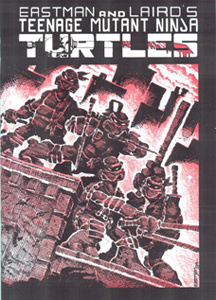As I journey through the vintage Mirage “Teenage Mutant Ninja Turtles” comics in this 30th anniversary year, I intend to review most of them in arcs or chunks of issues. But the May 1984 debut issue deserves its own entry, not only because this is where it all began, but also because the story behind it is so weird.
A new kind of mutant
I became a fan of TMNT via the movies and cartoons, so I was familiar with the sanitized version of the Turtles’ creation: In 1983 at his apartment/art studio in Northampton, Mass., Kevin Eastman started it all by drawing a turtle with nunchucks (presumably this is why it’s “Eastman and Laird” rather than “Laird and Eastman”).
He called it a “Ninja Turtle.” His friend and fellow artist Peter Laird added “Teenage Mutant.” An HBO “making of” featurette on the movie informed me that Splinter was inspired by Daredevil’s master, Stick. In general, it was all a joke — a joke that they hoped would attract buyers, but a joke just the same.

“Teenage Mutant Ninja Turtles” Issue 1 (1984)
Title: “The Turtles’ Origin is Told”
Writers: Kevin Eastman and Peter Laird
Pencils: Kevin Eastman and Peter Laird
Inks: Kevin Eastman and Peter Laird
At that time, “mutants” mostly meant the X-men, humans with genetic quirks that gave them superpowers. With possible exceptions like Beast, “X-men” didn’t delve into mutants in the sense of half-human, half-animal. TMNT moved “mutant” farther away from its scientific roots and firmly into off-the-wall sci-fi; indeed, the cartoons and toys took this version of mutant to colorful lengths, starting with Bebop and Rocksteady.
Because Eastman and Laird mostly worked in tandem, trading off drawing and inking duties, I don’t know who started and who finished individual panels. But let’s say Eastman started the double-page spread on pages 2 and 3 where Leo narrates “He’s wrong. We’re not wearing costumes” and the Turtles jump out at the reader, above the “TEENAGE MUTANT NINJA TURTLES” title.
When we saw this scene re-enacted in the opening of “TMNT II: The Secret of the Ooze,” we all thought, “Awesome!” But when Laird walked past and looked over Eastman’s shoulder, he probably said “Hilarious!” (I imagine a half-eaten bowl of ramen noodles and a few scattered dollar bills from Eastman’s restaurant job are next to the canvas.)
From lark to legend
On page 16, Splinter – telling the famous origin story – mentions that the mutagen canister flew from the back of a truck and “struck the young man near his eyes.” I used to think this odd, unnecessary detail came from amateur writers who might tend to overwrite or underwrite a passage here and there.
After all, the man who is hit in the face by the canister has nothing to do with anything, except that it bounced off him, shattered another bystander’s jar of pet turtles and knocked the whole works into the sewer, where the mutagen transformed Splinter and the turtles. But as the excellent website TMNT Entity explains, the man hit near the eyes with the canister is a direct parody of the way the “Daredevil” origin story is told in expository flashback.

Because I was young, I took the story of the back-and-forth vengeance between Yoshi and the Saki family at face value, but E&L probably were parodying the clichés of honor and vengeance in Japanese samurai movies. Presumably in the late-1960s (counting back from 1984, since the Mirage saga generally takes place in real time), when they were both members of the supposedly honorable (even though they perform assassinations) Japanese Foot Clan, Hamato Yoshi – Splinter’s owner — and Oroku Nagi were rivals for the affections of a woman, Tang Shen.
She chose Yoshi. Nagi killed her, then Yoshi killed Nagi. Then, in 1970 in New York, Nagi’s younger brother, Oroku Saki, killed Yoshi. Then in 1984, Splinter sends the Turtles out to kill Saki, a.k.a. The Shredder. One could make the case that it’s too convoluted to NOT be intended as a parody.
The use of narration by Leo (and briefly Raph) calls to mind Frank Miller’s “Sin City” – which, I admit, I’m more familiar with from the perfect 2006 movie than the comics – especially since “TMNT” shares the black-and-white aesthetic. By no means are E&L making fun of Miller (they are huge fans), but they are saying “Wouldn’t it be funny if we added noir narration to a story about mutant turtles?”
Accidental genius
But a weird thing about writing is that sometimes great new ideas grow out of old ideas, even if you’re laughing at the old ideas. “TMNT” No. 1 became a hit. No doubt some buyers thought it was a great parody, some thought it was a great original tale, and some were black-and-white indie comic speculators. At any rate, everyone who bought it agreed that it was fun, and they wanted more.
While the sense of humor and kitsch would be a part of many TMNT stories through the years, issue No. 2 was the first time that E&L really approached the TMNT story and characters seriously. A case could be made that Eastman and Laird ACCIDENTALLY created the TMNT saga in issue 1, then were compelled for commercial reasons to labor further on their mistakenly wonderful invention.
Indeed, some have argued that issue No. 1 doesn’t even distinguish between the four turtles’ personalities – there are several panels where there’s no way to tell which one is speaking –although I’d argue that point. It’s telling that Raph gleefully delivers the challenge to Shredder by hurling a sai, with Splinter’s hand-written note attached, through a window of Foot headquarters. (In the comic, unlike the first movie, Raph’s armory includes more than two sais.)
Later, after the Turtles kill Shredder and dozens of elite Foot soldiers, Mike says, “I’m tired, Leonardo,” which kind of paints him as the younger brother who is more of a follower. Leo, as the main narrator, is clearly the leader. Don, perhaps, is the soft-spoken one who literally carries a big stick, as he strikes the decisive blow against Shredder with his bo staff.
The definitive origin
Regardless of how much Eastman and Laird saw this issue as a joke, it’s rightly regarded as a classic today, and with the possible exception of the 1990 movie, as the most perfect, definitive version of the Turtles’ origin. Indeed, while the middle part of the movie draws from later Mirage issues, the start and finish come from Issue 1: The Turtles have their first battle in a dark alley (in the movie, they subdue muggers; in the comic, they KILL dozens of Purple Dragon Gang members), and in the end, they defeat the Shredder in a rooftop battle.
The clearly beaten Saki plans to take the Turtles with him by pulling the pin on a thermite grenade, but Don knocks the Shredder and the grenade off the roof, and the Shredder blows up. In the movie, the Shredder beats the crap out of the Turtles but then he gets arrogant and charges Splinter, who flings him off the roof and into a garbage truck.
Casey pulls the trash compactor lever, although – in the second movie — Shredder later wakes up at the dump, schemes to kill the turtles again, turns himself into SuperShredder and then is killed by a few falling planks of wood.
Issue 1 is a self-contained, complete story, as E&L intended. But perhaps all good yarns leave room for more good yarns to spring from it, even if the writer doesn’t initially intend it. (Another example: Michael Crichton’s “The Lost World” springing from “Jurassic Park.”) I have a feeling that when TMNT began to fly off the shelves, E&L – rather than worrying that they killed off the Shredder too quickly – had a blast dreaming up new stories.
For one thing, the Triceraton aliens (he’s a big fan of dinosaurs, particularly triceratops) and Fugitoid were actually invented by Laird before TMNT, and TMNT’s popularity gave him an opportunity to give these characters a spotlight. More on the Triceratons and Fugitoid when I get to those issues.
A sketchy Splinter
For another, Issue 1 is sketchy around the edges. Leo narrates that “We took a wrong turn somewhere” and ended up in Purple Dragon Gang territory. Later we learn that their utter slaughter of the gang members was their very first battle. So what were they doing wandering about? Practicing being stealthy? Scavenging for food? Even stealing food? Or maybe they were doing a Casey Jones-lite thing and looking to do a bit of vigilante crime-fighting if needed?
At any rate, once they win that first battle, Splinter is ready to use the Turtles to kill the Shredder – indeed, he’s been planning for this moment ever since he and the Turtles mutated 14 years earlier. In fact, Splinter tells the Turtles about their origin for the VERY FIRST TIME after the Purple Dragon Battle (in the more sensible and streamlined movie, Splinter tells the tale to April, with the Turtles themselves being well aware of their origin).
Although he prefaces his request with “I must ask you to do that which no being should ask of another,” Splinter is basically using his own surrogate sons as expendable deadly weapons. While the movie and cartoon (where Splinter actually IS Yoshi) would put him more on par with noble Jedi Knights, E&L originally paint Splinter with a much more flawed moral character, not only because he wants revenge on Saki, but because he thirsts for revenge at any cost to others, including his own family.
It’s weird – considering the much more upstanding versions of Splinter in other media – but it’s also a springboard for more exploration.
“TMNT” No. 1 boils down to this: Eastman and Laird set out to make a fun one-shot parody, and they ended up launching an entertainment empire. That’s arguably stranger than the idea of mutant ninja turtles itself.

